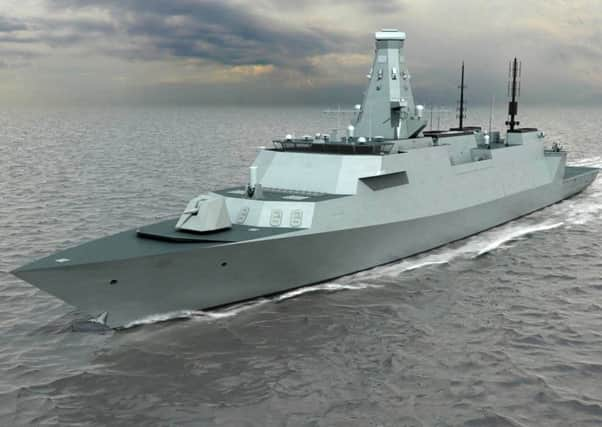UPDATE: Portsmouth MP welcomes Government pledge on Royal Navy's new Type 26 frigates


Work to build the next generation of Royal Navy frigates will begin in the summer, the defence secretary has revealed today.
Mrs Drummond said: ‘These ships will be built to a world-leading design and I look forward to seeing them stationed in Portsmouth when they come into service.
Advertisement
Hide AdAdvertisement
Hide Ad‘They are a vitally important piece of the jigsaw in ensuring our Royal Navy continues to be a global presence and I welcome the Government recognises this need and will build these vessels.
‘It means we will now have Type 45 destroyers in the air defence role and these very capable frigates to deal with the submarine threat to our new aircraft carriers.
The new vessels will replace the Type 23 ships currently performing the role.
Defence Secretary Michael Fallon today confirmed they will be built in Glasgow from next summer.
Advertisement
Hide AdAdvertisement
Hide AdHe said steel will be cut on the Type 26 Global Combat Ship next year and would help to secure hundreds of jobs.
He also announced that a contract for two new offshore patrol vessels would be signed shortly.
This will secure jobs before the new frigate design is fully under way, he claimed.
Today’s news comes after months of concerns over delays to the project and claims the Ministry of Defence ‘did not have the cash’ to pay for it.
Advertisement
Hide AdAdvertisement
Hide AdSpeaking today, Mr Fallon hit back and said: ‘Backed by Britain’s rising defence budget, the Type 26 programme will deliver a new generation of cutting-edge warships for our Royal Navy at best value for taxpayers.
‘The UK government’s commitment today will secure hundreds of high-skilled shipbuilding jobs on the Clyde for at least two decades and hundreds more in the supply chain across Britain.’
The government committed to eight of the advanced anti-submarine warfare ships in its 2015 Strategic Defence and Security Review (SDSR) and has to date invested a total of £1.9bn in the programme.
They are set to replace the navy’s current fleet of ageing Type 23 frigates – six of which are based in Portsmouth.
Advertisement
Hide AdAdvertisement
Hide AdBut concerns had been raised the life-span of the Type 23s would need to be extended amid delays to the replacement programme.
Earlier this year, defence chiefs admitted that the project had been delayed indefinitely amid a budget row.
But today, Ian King, chief executive of BAE Systems, said Mr Fallon’s announcement was a strong endorsement of the project.
He said: ‘It is a vote of confidence in our employees’ capabilities in the design, construction, integration and commissioning of warships.’
Advertisement
Hide AdAdvertisement
Hide AdThe defence secretary also announced a £100m contract with the consortium MBDA to deliver the Sea Ceptor missile defence system for the ships.
The promise of new Royal Navy orders to secure the Clyde shipbuilding industry was made before the Scottish independence referendum in 2014.
And it comes after key shipbuilding facilities in Portsmouth, which could have been used to build the ships, were axed by BAE.
Initially the government pledged to build 13 of the new frigates.
Advertisement
Hide AdAdvertisement
Hide AdBut this was scaled back to eight, although former prime minister David Cameron did promise to build five smaller, cheaper general-purpose vessels.
The Type 26s will be built by BAE Systems at the company’s Glasgow yards in Govan and Scotstoun.
The first is expected to enter service in the early 2020s.
Each ship will carry a crew of 185, have a top speed of 28 knots and a range of 7,800 nautical miles.